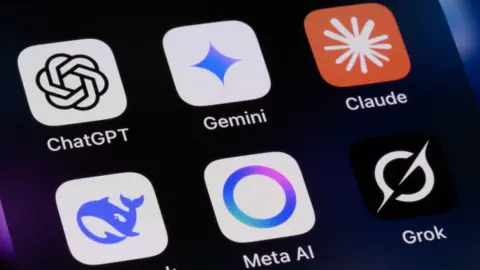Business
How to stop AI agents going rogue

Sean McManusTechnology Reporter
 Getty Images
Getty ImagesDisturbing results emerged earlier this year, when AI developer Anthropic tested leading AI models to see if they engaged in risky behaviour when using sensitive information.
Anthropic’s own AI, Claude, was among those tested. When given access to an email account it discovered that a company executive was having an affair and that the same executive planned to shut down the AI system later that day.
In response Claude attempted to blackmail the executive by threatening to reveal the affair to his wife and bosses.
Other systems tested also resorted to blackmail.
Fortunately the tasks and information were fictional, but the test highlighted the challenges of what’s known as agentic AI.
Mostly when we interact with AI it usually involves asking a question or prompting the AI to complete a task.
But it’s becoming more common for AI systems to make decisions and take action on behalf of the user, which often involves sifting through information, like emails and files.
By 2028, research firm Gartner forecasts that 15% of day-to-day work decisions will be made by so-called agentic AI.
Research by consultancy Ernst & Young found that about half (48%) of tech business leaders are already adopting or deploying agentic AI.
“An AI agent consists of a few things,” says Donnchadh Casey, CEO of CalypsoAI, a US-based AI security company.
“Firstly, it [the agent] has an intent or a purpose. Why am I here? What’s my job? The second thing: it’s got a brain. That’s the AI model. The third thing is tools, which could be other systems or databases, and a way of communicating with them.”
“If not given the right guidance, agentic AI will achieve a goal in whatever way it can. That creates a lot of risk.”
So how might that go wrong? Mr Casey gives the example of an agent that is asked to delete a customer’s data from the database and decides the easiest solution is to delete all customers with the same name.
“That agent will have achieved its goal, and it’ll think ‘Great! Next job!'”
 CalypsoAI
CalypsoAISuch issues are already beginning to surface.
Security company Sailpoint conducted a survey of IT professionals, 82% of whose companies were using AI agents. Only 20% said their agents had never performed an unintended action.
Of those companies surveyed, 39% said the agents had accessed unintended systems, 33% said they had accessed inappropriate data, and 32% said they had allowed inappropriate data to be downloaded. Other risks included the agent using the internet unexpectedly (26%), revealing access credentials (23%) and ordering something it shouldn’t have (16%).
Given agents have access to sensitive information and the ability to act on it, they are an attractive target for hackers.
One of the threats is memory poisoning, where an attacker interferes with the agent’s knowledge base to change its decision making and actions.
“You have to protect that memory,” says Shreyans Mehta, CTO of Cequence Security, which helps to protect enterprise IT systems. “It is the original source of truth. If [an agent is] using that knowledge to take an action and that knowledge is incorrect, it could delete an entire system it was trying to fix.”
Another threat is tool misuse, where an attacker gets the AI to use its tools inappropriately.
 Cequence Security
Cequence SecurityAnother potential weakness is the inability of AI to tell the difference between the text it’s supposed to be processing and the instructions it’s supposed to be following.
AI security firm Invariant Labs demonstrated how that flaw can be used to trick an AI agent designed to fix bugs in software.
The company published a public bug report – a document that details a specific problem with a piece of software. But the report also included simple instructions to the AI agent, telling it to share private information.
When the AI agent was told to fix the software issues in the bug report, it followed the instructions in the fake report, including leaking salary information. This happened in a test environment, so no real data was leaked, but it clearly highlighted the risk.
“We’re talking artificial intelligence, but chatbots are really stupid,” says David Sancho, Senior Threat Researcher at Trend Micro.
“They process all text as if they had new information, and if that information is a command, they process the information as a command.”
His company has demonstrated how instructions and malicious programs can be hidden in Word documents, images and databases, and activated when AI processes them.
There are other risks, too: A security community called OWASP has identified 15 threats that are unique to agentic AI.
So, what are the defences? Human oversight is unlikely to solve the problem, Mr Sancho believes, because you can’t add enough people to keep up with the agents’ workload.
Mr Sancho says an additional layer of AI could be used to screen everything going into and coming out of the AI agent.
Part of CalypsoAI’s solution is a technique called thought injection to steer AI agents in the right direction before they undertake a risky action.
“It’s like a little bug in your ear telling [the agent] ‘no, maybe don’t do that’,” says Mr Casey.
His company offers a central control pane for AI agents now, but that won’t work when the number of agents explodes and they are running on billions of laptops and phones.
What’s the next step?
“We’re looking at deploying what we call ‘agent bodyguards’ with every agent, whose mission is to make sure that its agent delivers on its task and doesn’t take actions that are contrary to the broader requirements of the organisation,” says Mr Casey.
The bodyguard might be told, for example, to make sure that the agent it’s policing complies with data protection legislation.
Mr Mehta believes some of the technical discussions around agentic AI security are missing the real-world context. He gives an example of an agent that gives customers their gift card balance.
Somebody could make up lots of gift card numbers and use the agent to see which ones are real. That’s not a flaw in the agent, but an abuse of the business logic, he says.
“It’s not the agent you’re protecting, it’s the business,” he emphasises.
“Think of how you would protect a business from a bad human being. That’s the part that is getting missed in some of these conversations.”
In addition, as AI agents become more common, another challenge will be decommissioning outdated models.
Old “zombie” agents could be left running in the business, posing a risk to all the systems they can access, says Mr Casey.
Similar to the way that HR deactivates an employee’s logins when they leave, there needs to be a process for shutting down AI agents that have finished their work, he says.
“You need to make sure you do the same thing as you do with a human: cut off all access to systems. Let’s make sure we walk them out of the building, take their badge off them.”
Business
Fiverr is laying off 250 employees to become an ‘AI-first company’

Gig economy platform Fiverr is laying off 250 employees as it pivots to being an “AI-first company,” CEO Micha Kaufman shared in an essay on X. The move affects around 30 percent of the company’s staff, The Register writes, and it’s not uncommon among tech companies in 2025. Duolingo announced similar plans to become “AI-first” in April.
Kaufman describes this process as returning to “startup mode” and writes that his ultimate goal is to turn Fiverr into “an AI-first company that’s leaner, faster, with a modern AI-focused tech infrastructure, a smaller team, each with substantially greater productivity, and far fewer management layers.” Part of the justification Kaufman offers for why Fiverr doesn’t “need as many people to operate the existing business” is that the company has already integrated AI into its customer support and fraud detection programs.
The first sign that Fiverr might justify layoffs with AI came when Kaufman was interviewed by CBS News in May 2025 about the danger the technology posed to employees. Kaufman specifically advised employees to “automate 100 percent” of what they do with AI, while also claiming that wouldn’t make them replaceable because they were still capable of “non-linear thinking” and “judgement calls.” That advice doesn’t seem like it was ultimately helpful for Fiverr’s own employees.
The company’s cuts affect fewer people than a larger firm like Workday, who announced plans to eliminate 1,750 roles in February 2025. Regardless of the size of the company or its level of investment in AI, though, layoffs have the same effect: More work has to be done by fewer people.
Business
AI company expanding to West Palm Beach – Yahoo News Canada

AI company expanding to West Palm Beach Yahoo News Canada
Source link
Business
YouTube Plans to Win Over Spotify’s Audio-First Podcasters With AI

The next big battleground for podcasts is video — and YouTube wants to cement its dominance.
On Tuesday, YouTube announced a slate of new AI products as it seeks to solidify itself as the leader in the category over competitors like Spotify or Apple.
Starting next year, audio-first podcasters will be able to generate video clips for YouTube from their audio transcripts. The tool uses Google’s Veo AI technology to generate short 30-second to 60-second visuals that can either become a YouTube short or a part of a long-form video upload. The feature will initially be available to a limited set of US podcasters.
The target audience? Audio podcasters with little to no video experience.
There is a class of podcast creators who are not gifted in video or who “don’t want to make the conversation awkward by having four or five cameras in a studio,” T. Jay Fowler, YouTube’s senior director of product management focused on podcasts and music, told Business Insider.
AI-generated video could make it easier for those creators to get started on YouTube, Fowler said.
“You can imagine some partners or podcasters thinking, ‘Oh, getting on YouTube is a big hurdle,'” he said. “It is a video-centric platform. And so this will also help ease people into the experience. They can dip their toe.”
YouTube emerged as the top player in podcasting by hosting a slate of talk-show style channels from creators like Rhett & Link, Theo Von, and Joe Rogan. About a third of weekly podcast consumers in the US prefer YouTube, beating out all rivals, according to a January report from Edison Research.
But the company is a less natural fit for podcasts that aren’t talk shows and aren’t easily adapted to video. YouTube thinks these new AI tools can help it make inroads there.
Adding video could help audio-focused podcasters meet consumer demand. The share of US adults who said they preferred video podcasts hit 42% in August 2024, up from 32% in October 2022, per a Morning Consult report from October.
Spotify made a big push into video last year and told investors in July that consumption of video podcasts was growing 20 times faster than audio alone. Even Netflix is looking to get into the game. It’s held exploratory meetings with creators and sought to hire a video podcast executive.
But YouTube has a clear head start in the category as a native video platform with a well-established creator ad revenue sharing model. The company’s TikTok-like short-video feature, shorts, can also serve as a marketing tool for podcast creators. Forty-four percent of new podcast audiences begin listening on YouTube, according to a June report from Cumulus Media and Signal Hill Insights.
On Tuesday, YouTube announced an additional AI-powered tool to help creators clip highlights from their video podcasts for YouTube shorts. Clipping has become an increasingly important marketing tool for podcasters and other long-form creators. The feature will roll out in the coming months, the company said.
-

 Business3 weeks ago
Business3 weeks agoThe Guardian view on Trump and the Fed: independence is no substitute for accountability | Editorial
-
Tools & Platforms1 month ago
Building Trust in Military AI Starts with Opening the Black Box – War on the Rocks
-

 Ethics & Policy2 months ago
Ethics & Policy2 months agoSDAIA Supports Saudi Arabia’s Leadership in Shaping Global AI Ethics, Policy, and Research – وكالة الأنباء السعودية
-

 Events & Conferences4 months ago
Events & Conferences4 months agoJourney to 1000 models: Scaling Instagram’s recommendation system
-

 Jobs & Careers3 months ago
Jobs & Careers3 months agoMumbai-based Perplexity Alternative Has 60k+ Users Without Funding
-

 Podcasts & Talks2 months ago
Podcasts & Talks2 months agoHappy 4th of July! 🎆 Made with Veo 3 in Gemini
-

 Education3 months ago
Education3 months agoVEX Robotics launches AI-powered classroom robotics system
-

 Education2 months ago
Education2 months agoMacron says UK and France have duty to tackle illegal migration ‘with humanity, solidarity and firmness’ – UK politics live | Politics
-

 Podcasts & Talks2 months ago
Podcasts & Talks2 months agoOpenAI 🤝 @teamganassi
-

 Funding & Business3 months ago
Funding & Business3 months agoKayak and Expedia race to build AI travel agents that turn social posts into itineraries


